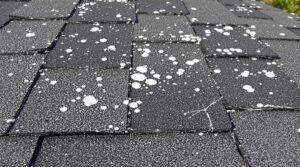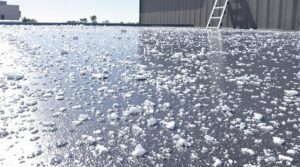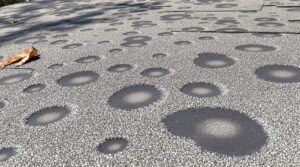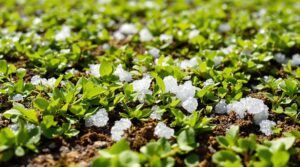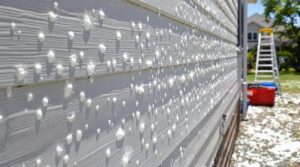Is your rolled roof showing battle scars from a recent hailstorm? Let's dive into what you need to know about those pesky ice pellets and your roofing.
Think of hail damage like nature's golf balls hitting your roof – creating telltale circular dents, mysterious dark patches, and bald spots where protective granules once lived. Just as you'd want a doctor to check out unexplained symptoms, your roof deserves a professional assessment to uncover the true extent of storm damage.
Here's the reality check: dealing with hail damage isn't cheap. While a typical repair bill hovers around $12,000, your actual costs might swing higher or lower depending on your roof's size and damage severity. You might get away with spot fixes, but sometimes a complete roof makeover is your best bet.
Want a pro tip? Don't go solo on your insurance claim. Homeowners who team up with public adjusters often see dramatically better results – we're talking settlements up to 800% higher than going it alone. Think of these adjusters as your roof's legal advocates, fighting for every dollar you deserve.
Your best defense? Know your stuff. Understanding how hail leaves its mark, keeping detailed records (yes, those smartphone photos matter!), and navigating the claims maze can mean the difference between a fair settlement and leaving money on the table. Your roof's health – and your wallet – will thank you later.
Key Takeaways
Is Your Rolled Roof Telling You a Hail-of-a Story?
Think of your rolled roofing like a battle-worn shield – those dark spots and circular dents aren't just cosmetic bruises. When hailstones larger than a golf ball come knocking, they leave behind a distinctive calling card of tears, soft spots, and unsightly bruising that you can't ignore.
Let's talk numbers: dealing with Mother Nature's ice pellets isn't cheap. While the average insurance claim hovers around $12,000, savvy homeowners who team up with public adjusters often see their settlements multiply dramatically – we're talking 3-8 times more than initial offers.
Ever wondered how the pros spot what you can't see? Today's roof inspectors are like modern-day detectives, armed with thermal imaging cameras and high-tech gear to crack the case of hidden water damage and sneaky leak patterns.
When it comes to fixing your roof's hail scars, you've got options. From patching up those pesky punctures to giving your roof a complete makeover, your wallet's hit will depend on where you call home. Think of it as choosing between a band-aid and major surgery – each has its time and place.
Want to keep your roof fighting fit? Regular TLC is your best friend. Clean those gutters, schedule check-ups, and consider upgrading to hail-resistant materials – it's like giving your roof a suit of armor against nature's bowling balls.
Remember: catching these issues early isn't just about maintaining your home's hat – it's about protecting everything underneath it!
Understanding Rolled Roofing and Its Vulnerabilities
When examining roofing materials for low-slope applications, rolled roofing emerges as a common choice due to its distinctive composition and installation characteristics.
The material composition consists of asphalt-integrated felt or fiberglass mats, often enhanced with modified bitumen coating for waterproofing. Its layering techniques incorporate mineral granules for UV protection and weather resistance. Storm resistant materials can help minimize damage during severe weather events.
Modified bitumen and mineral granules work together to create a waterproof shield against UV rays and harsh weather conditions.
While rolled roofing offers advantages such as seamless application and cost-effectiveness, it exhibits notable vulnerabilities to hail impact.
The relatively thin profile and lower density make it susceptible to cracks, tears, and granule loss when subjected to hail storms. These structural weaknesses can compromise the roofing system's integrity, potentially leading to water infiltration and accelerated deterioration. Understanding these vulnerabilities is essential for property owners considering rolled roofing installation or facing potential hail damage.
Severe damage typically occurs when hailstones reach 1.5 inches diameter or larger, often requiring immediate professional assessment.
Common Signs of Hail Damage on Rolled Roofs

On rolled roofing surfaces, hail damage manifests through several distinct indicators that property owners and inspectors must recognize.
These signs typically involve surface patterns that deviate from normal wear, indicating material breakdown from impact trauma. Weather pattern variations can accelerate the visibility of hail damage during seasonal changes.
Visual identification reveals granule displacement, texture changes, and exposed underlayment that compromise the roof's protective capabilities.
Key visual indicators include:
- Dark spots or patches where surface granules have been stripped away
- Circular or dimpled indentations across the roofing material
- Tears, rips, or punctures that penetrate through the outer layer
When these signs appear, immediate attention is necessary to prevent further deterioration.
The compromised areas create vulnerability points where water infiltration can occur, potentially leading to more extensive structural issues if left unaddressed.
Professional inspectors often find that soft spots and bruising indicate significant structural damage requiring immediate repair to maintain roof integrity.
Assessing the Severity of Storm Impact
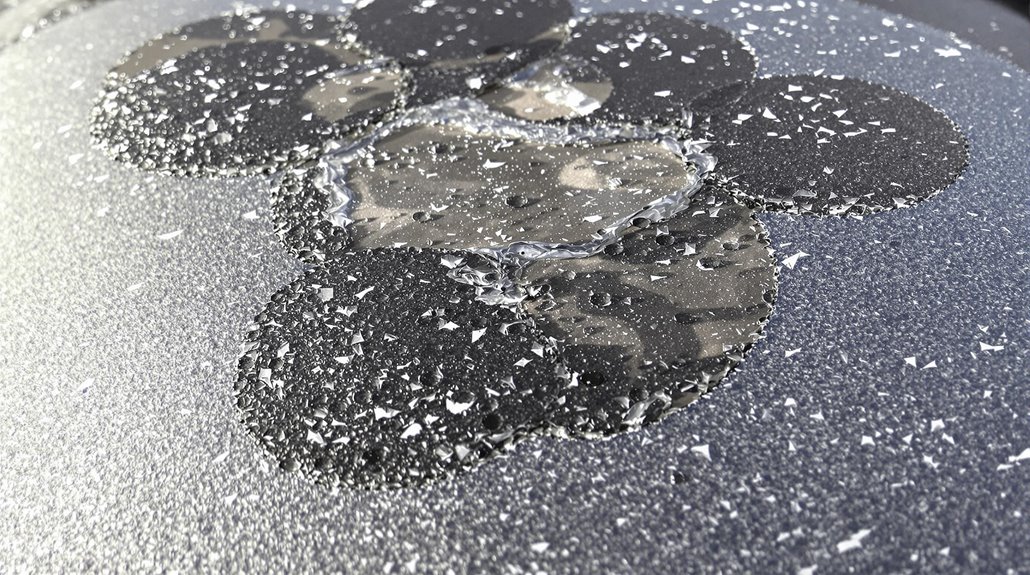
A complete assessment of hail storm impact requires systematic evaluation of multiple damage indicators across rolled roofing surfaces. Professional inspectors examine impact distribution patterns to determine storm intensity and direction, while material testing reveals the full extent of structural compromise.
Key assessment factors include hail size evidence, velocity indicators, and the roof's pre-existing condition.
The evaluation process encompasses detailed visual inspection, thorough documentation through photographs and written reports, and careful analysis of material integrity. Inspectors must consider wind patterns that may have concentrated damage in specific areas. Public adjuster services can provide unbiased evaluations that document both visible and hidden damages.
Thorough inspection and documentation of material damage must account for wind patterns that can intensify impact in localized areas.
Additionally, they evaluate the rolled roofing's water-shedding capabilities by checking for tears, punctures, and surface degradation. This systematic approach guarantees accurate damage assessment for insurance claims and repair planning.
Homeowners should check for dark circular bruises and exposed underlayment immediately after severe storms to prevent extensive damage.
Immediate Steps After Discovering Damage
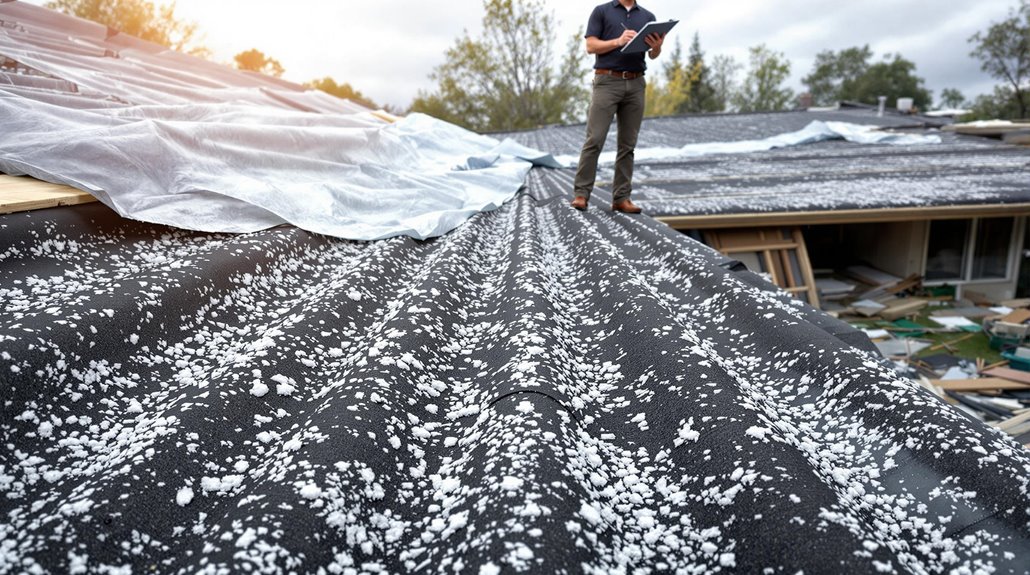
Following the discovery of hail damage on rolled roofing, property owners must take swift and methodical action to prevent further deterioration and protect their interests.
Immediate damage documentation through photographs and videos serves as critical evidence for insurance claims.
Emergency fixes, such as applying protective tarps, help prevent water infiltration and additional structural complications.
Essential immediate actions include:
- Securing detailed photographs of all visible damage points
- Installing temporary protective barriers over compromised areas
- Contacting insurance providers to initiate the claims process
Property owners should prioritize professional inspection to assess the full extent of damage while maintaining detailed records of all communications and repair estimates.
This systematic approach guarantees proper documentation for insurance purposes while protecting the structure from secondary damage through appropriate emergency measures.
Owners may benefit from hiring public claims adjusters who typically achieve significantly higher settlement amounts for hail damage claims.
Professional assessments from qualified contractors provide critical third-party validation that strengthens the credibility of insurance claims.
Professional Inspection and Documentation
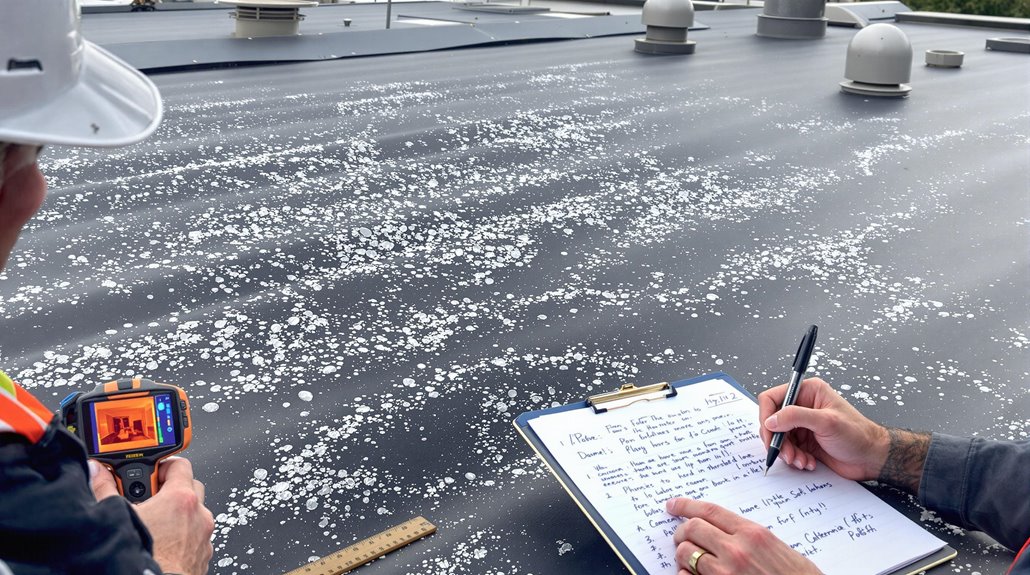
Professional inspection and thorough documentation form the cornerstone of successful hail damage assessment for rolled roofing systems. Certified contractors utilize Professional Equipment to conduct exhaustive evaluations, examining not only the rolled roofing material but also affiliated components like vents, flashings, and drainage systems.
The inspection process generates Technical Documentation essential for insurance claims, including detailed photographs with measurement references, written assessments of damage patterns, and specific repair recommendations. Thermal imaging analysis helps identify hidden damage that may not be visible to the naked eye.
Contractors provide expert documentation of visible and hidden damage, supporting insurance claims with precise measurements and professional reports. This systematic approach guarantees that all damage is properly identified, recorded, and substantiated for insurance adjusters, streamlining the claims process and maximizing the likelihood of appropriate coverage for necessary repairs.
Claims filed with professional adjuster assistance typically result in 15-40% higher settlement amounts compared to self-filed claims.
Repair Options and Cost Breakdown
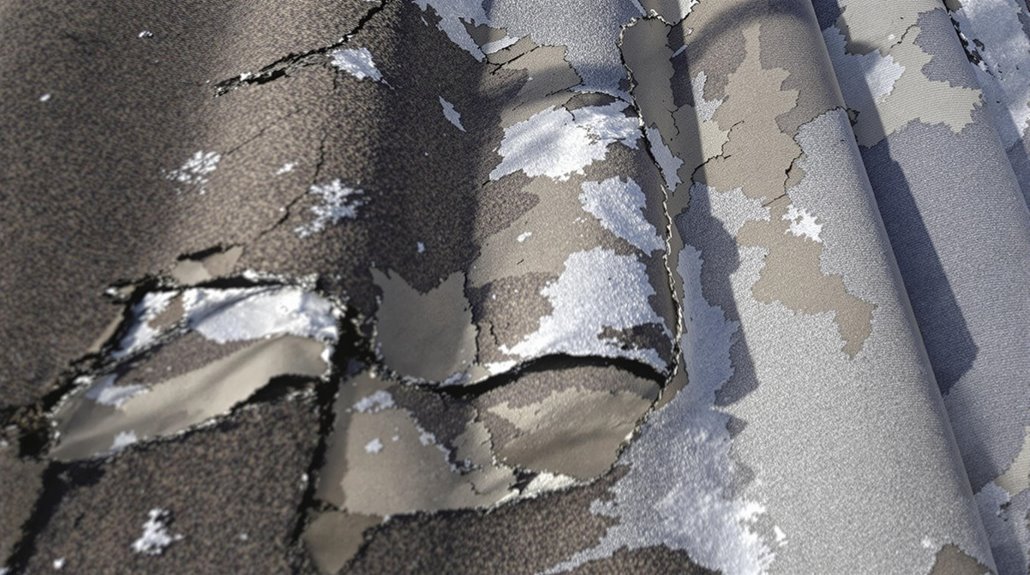
Complete repair solutions for hail-damaged rolled roofing range from minor spot fixes to complete system replacement, each with distinct cost implications.
Material selection and cost planning are critical factors in determining the most effective repair strategy.
Professional assessments help identify whether localized repairs or full replacement is necessary, considering the roof's age and overall condition. Damage evaluation experts can provide detailed documentation to strengthen insurance claims.
- Small punctures and isolated damage often require simple spot repairs with matching rolled roofing material and sealant
- Moderate damage may necessitate sectional replacement, including waterproofing layers and proper overlap
- Severe hail impact typically demands complete system replacement, especially on aging roofs
Labor costs vary by region and project scope, while material expenses depend on quality grade and quantity required. Insurance coverage often influences the selection of repair methods and materials.
Engaging a public insurance adjuster can increase claim settlements by 300-400% for roof repair coverage.
Working With Insurance Companies
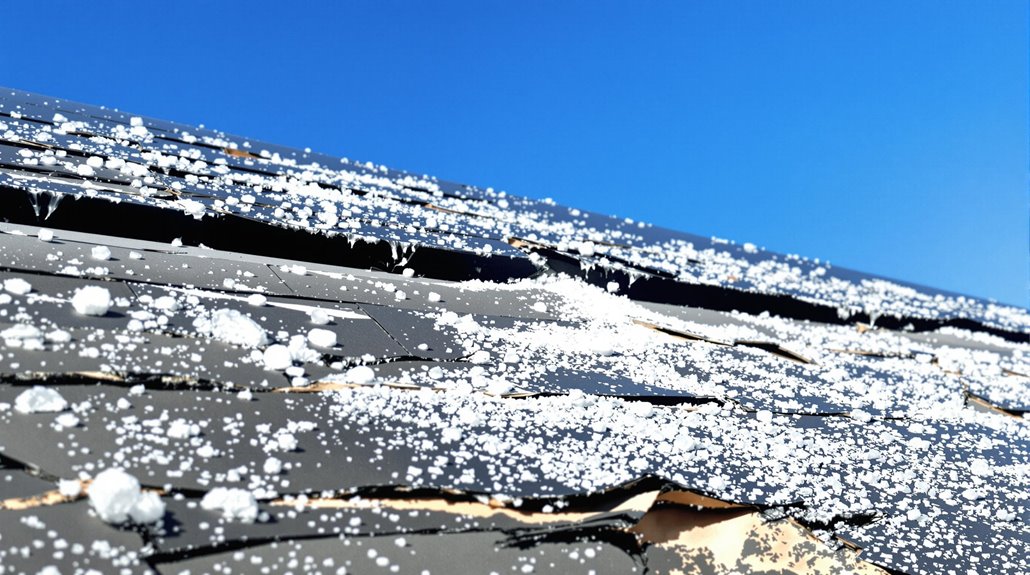
Successfully maneuvering the insurance claims process for rolled roof hail damage requires thorough documentation and a clear understanding of policy coverage. Property owners must document damage immediately with detailed photographs, measurements, and professional assessments to strengthen their claims. With average hail damage claims reaching $12,000 per incident, thorough preparation is critical for maximum reimbursement.
| Action Item | Key Considerations |
|---|---|
| Documentation | Photos, videos, damage measurements |
| Adjuster Meetings | Schedule promptly, prepare evidence |
| Policy Review | Coverage limits, exclusions |
| Professional Support | Public adjuster consultation |
Maintaining positive adjuster relationships while advocating for fair settlements is essential. Property owners should thoroughly understand their policy terms to prevent claim denials. Presenting extensive evidence, including professional inspections and detailed repair estimates, substantially improves the likelihood of successful claims. Working with qualified professionals who understand rolled roofing specifications can provide valuable support during negotiations. Studies show that homeowners who employ public insurance adjusters receive settlements up to 800% higher than those filing claims independently.
Preventative Measures for Future Protection
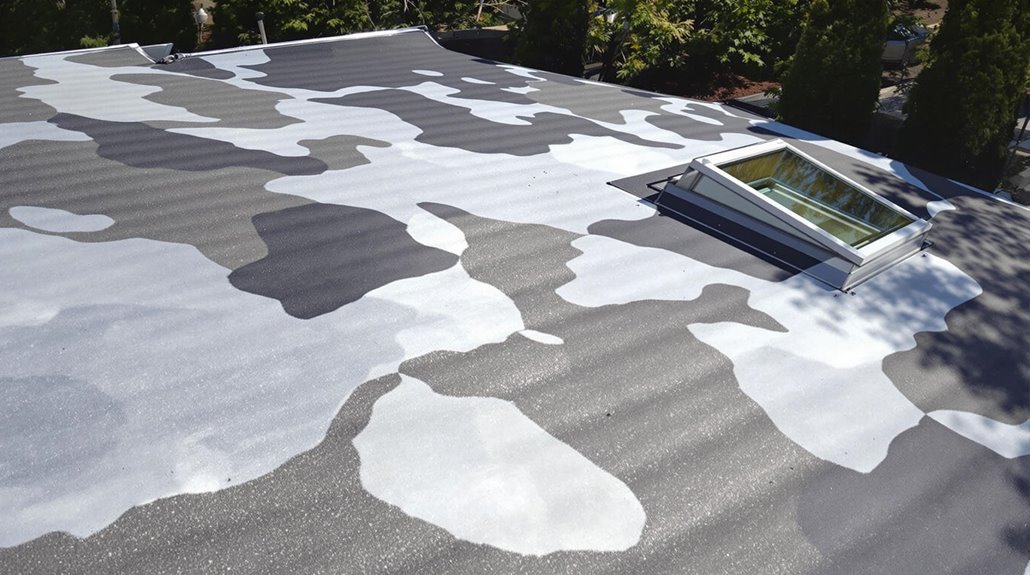
Taking proactive steps to protect rolled roofing from hail damage can substantially extend its lifespan and reduce repair costs.
Implementing thorough preventative measures begins with proper barrier installation, including impact-resistant underlayment and protective coverings for vulnerable areas.
A structured maintenance schedule guarantees regular inspections and timely repairs of potential weak points.
Key protective measures include:
- Installing hail-resistant materials and guards around skylights and windows
- Maintaining clear gutters and trimming overhanging branches
- Documenting roof conditions with regular inspections and photos
Professional assessments, combined with proper material selection and installation techniques, create a robust defense against hail damage.
Missing granules and surface bruising are critical warning signs that require immediate attention from certified inspectors.
Building codes and insurance requirements should guide the selection of appropriate protective materials, while systematic maintenance protocols help preserve the roof's integrity over time.
Working with public adjusters can improve insurance claim settlements by 2-3 times the initial offer when documenting hail damage.
Long-term Impact on Property Value
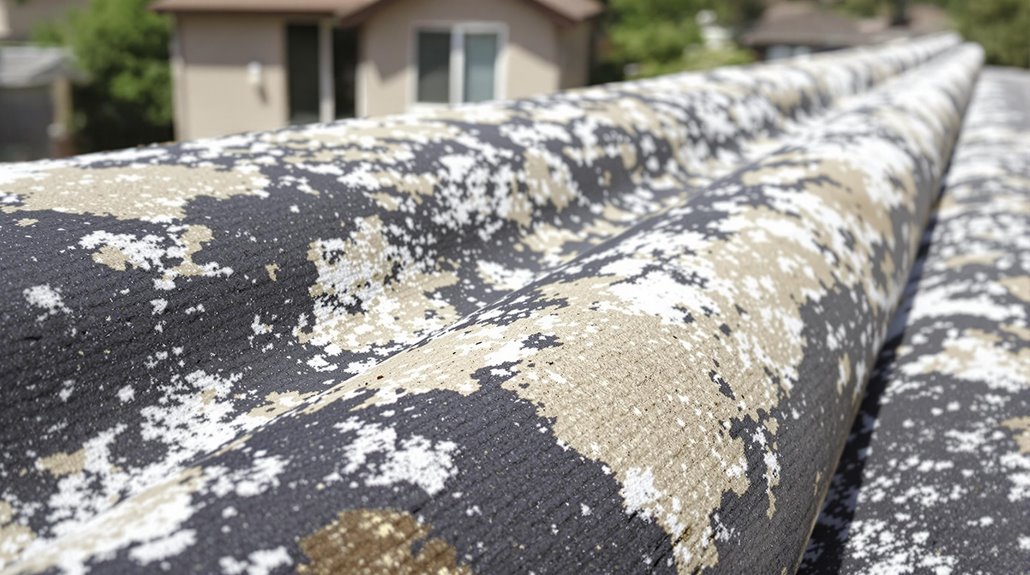
Hail damage to rolled roofing substantially impacts property value through three primary channels: market perception, structural integrity, and ongoing maintenance costs. Properties with unaddressed hail damage typically experience market shifts resulting in prolonged listing periods and reduced selling prices.
Deferred maintenance of hail-damaged rolled roofing often leads to compounding issues, including potential water infiltration and structural deterioration. These problems can trigger escalating repair costs and decrease the property's marketability. Working with public adjusters nationwide can help maximize claim settlements and ensure comprehensive damage documentation.
Insurance claims, while providing financial relief, may result in higher premiums and affect future coverage options. Professional appraisals frequently reveal that damaged properties face value reductions not only from visible exterior damage but also from buyers' perceptions of risk and anticipated repair expenses. This impact becomes particularly pronounced in rental properties, where damage can affect both tenant retention and rental income. Homeowners can expect to receive average claim payouts of approximately $12,000 for comprehensive hail damage repairs.
The Benefits Of Consulting A Public Adjuster For Hail Damage Claims
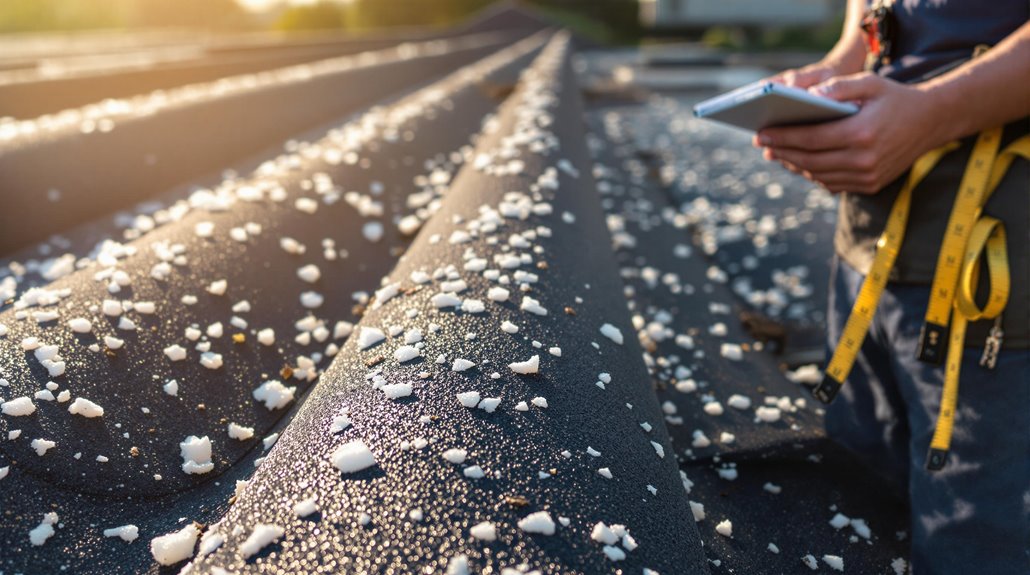
Public adjusters provide essential expertise in maneuvering complex hail damage insurance claims through their exhaustive understanding of policy terms and settlement procedures.
Their objective damage assessments and thorough documentation create a strong foundation for maximizing claim payouts, often resulting in higher settlements compared to self-filed claims.
The streamlined process they implement reduces administrative burden while ensuring all damages are properly identified, documented, and included in the final settlement.
Studies show policyholders who utilize public adjuster services receive settlements averaging $22,266 compared to $18,659 for those handling claims independently.
With state filing deadlines varying significantly across jurisdictions, public adjusters help ensure claims are submitted within required timeframes to avoid coverage denials.
Expertise In Insurance Claims
Insurance claims involving hail damage require specialized expertise to navigate complex policy terms and secure fair compensation.
Public adjusters possess extensive claim expertise and professional qualifications necessary to maximize settlements for property owners.
Their understanding of insurance procedures and negotiation strategies guarantees thorough damage assessment and appropriate valuation.
Key areas of professional expertise include:
- Technical evaluation of both visible and concealed hail damage patterns
- Detailed documentation and cost estimation methodologies
- Strategic interpretation of policy coverage and exclusions
Public adjusters streamline the claims process through their experience with insurance companies and understanding of industry standards.
Their specialized knowledge enables accurate damage verification, proper depreciation calculations, and effective dispute resolution, resulting in expedited claim processing and maximum financial outcomes for policyholders.
Objective Damage Assessment
Selecting a qualified public adjuster for hail damage assessment provides property owners with essential objectivity and professional expertise throughout the claims process. Professional adjusters utilize systematic approaches to identify Visual Indicators while conducting Expert Assessment of rolled roof damage.
| Assessment Component | Benefit to Property Owner |
|---|---|
| Documentation | Detailed evidence gathering of all damage points |
| Inspection Protocol | Professional evaluation of visible and hidden damage |
| Damage Verification | Scientific analysis of hail impact patterns |
| Settlement Analysis | Thorough review of repair vs. replacement costs |
These professionals guarantee accurate damage documentation while maintaining independence from insurance companies, leading to fair compensation. Their expertise helps distinguish legitimate hail damage from normal wear, strengthening the claim's validity and increasing the likelihood of appropriate settlements for property owners.
Streamlined Claim Process
When property owners face complex hail damage claims, consulting a public adjuster can dramatically streamline the settlement process while maximizing compensation potential.
These licensed professionals manage claim deadlines and implement thorough documentation strategies while negotiating with insurers on the policyholder's behalf.
Public adjusters provide critical advantages:
- Thorough assessment of visible and hidden damage to guarantee complete compensation
- Expert interpretation of policy language to counter unfair depreciation tactics
- Professional documentation and presentation of evidence to support maximum settlement
Operating independently from insurance companies, public adjusters work on commission, aligning their interests with the policyholder's goals.
Their expertise in regulatory compliance and industry practices helps expedite claims while protecting property owners from common settlement disputes and undervaluation issues.
Higher Claim Payouts & Settlements
Statistical data consistently demonstrates that property owners who engage public adjusters for hail damage claims receive substantially higher settlement amounts compared to those who handle claims independently.
Public adjusters employ expert negotiation tactics to maximize claim value through exhaustive damage assessments, detailed documentation, and professional representation during settlement discussions.
These licensed professionals leverage their extensive knowledge of insurance policies and industry experience to guarantee maximum settlement potential.
Their thorough understanding of policy provisions, combined with sophisticated documentation methods, helps identify damages that might otherwise go unnoticed.
Operating on a commission basis, public adjusters are inherently motivated to secure the highest possible payout while maintaining compliance with legal requirements and policy terms. Their expertise in dispute resolution and strategic negotiations often results in more favorable outcomes for property owners.
About The Public Claims Adjusters Network (PCAN)
The Public Claims Adjusters Network (PCAN) operates as a professional organization connecting licensed public adjusters across the United States.
Through industry collaboration, this network enables adjusters to share expertise, resources, and best practices in handling complex insurance claims, particularly those involving hail damage to rolled roofing systems.
Network benefits for member adjusters include:
- Access to specialized knowledge in policy interpretation and claim documentation
- Shared resources for accurate damage assessment and cost estimation
- Professional development through peer collaboration and expertise exchange
PCAN members must maintain proper state licensure and adhere to strict ethical standards while serving their clients.
The organization facilitates communication between adjusters, ensuring policyholders receive thorough representation during their insurance claims process. This structured approach helps maximize claim settlements while maintaining compliance with state regulations.
References
- http://smrhomepros.com/hail-damage-metal-roof/
- https://www.insuranceclaimrecoverysupport.com/hail-damage-roof-insurance-claim-process/
- https://www.honestaberoofing.com/about-us/blog/2024/june/how-to-spot-previous-hail-damage-on-a-roof
- https://claimsmate.com/important-things-you-need-to-know-about-roof-hail-damage-insurance-claims/
- https://countyorgprodblob2023.blob.core.usgovcloudapi.net/cms/tac/media/default/member-services/risk-management/disaster/checklist-to-spot-roof-hail-damage-jc-final-april-2022.pdf
- https://www.roof-crafters.com/learn/what-is-rolled-roofing
- https://rolandslate.com/understanding-hail-damage-roof-repair-solutions/
- https://www.proline-roofing.com/rolled-roofing-guide/
- https://comoexteriors.com/top-signs-of-hail-damage-roof-issues-solutions-central-missouri/
- https://trentonroofing.com/blog/the-homeowners-handbook-what-is-rolled-roofing/


